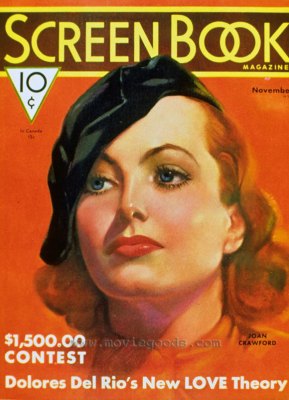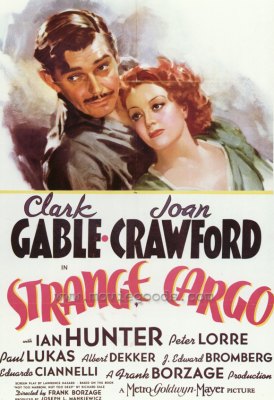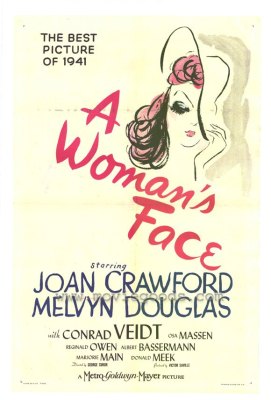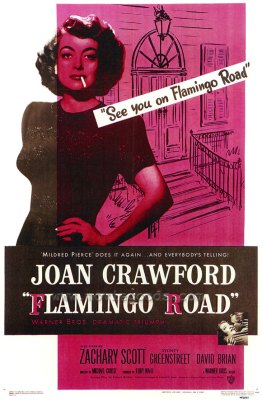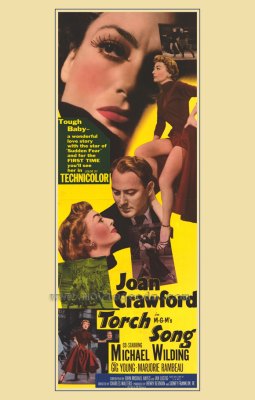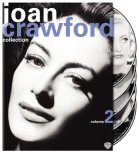| Reviews & Columns |
|
Reviews DVD TV on DVD Blu-ray 4K UHD International DVDs In Theaters Reviews by Studio Video Games Features Collector Series DVDs Easter Egg Database Interviews DVD Talk Radio Feature Articles Columns Anime Talk DVD Savant Horror DVDs The M.O.D. Squad Art House HD Talk Silent DVD
|
DVD Talk Forum |
|
|
| Resources |
|
DVD Price Search Customer Service #'s RCE Info Links |
|
Columns
|
|
|
Joan Crawford Collection - Volume 2 (Sadie McKee / Strange Cargo / A Woman's Face / Flamingo Road / Torch Song)
Sadie McKee (1934)
Leonard Maltin describes this story of a lowly housemaid and the three men in her life as "serpentine," which is pretty accurate. Though only 93 minutes long, it's like three very different movies in one. After Sadie McKee's (Crawford) rich employers, including handsome lawyer Michael Alderson (Franchot Tone), condemn Sadie's no-good boyfriend, Tommy Wallace (Gene Raymond, here looking rather like Bruce Willis), she decides to join him when he looks for a job in New York City.
This being the height of the Great Depression, the pair pinch every penny, fretting over the $7/week for their single room apartment, or lavishing five cents on a pricey cup of coffee. They decide to get married anyway, but then he deserts her at the last minute, seduced into joining Dolly Merrick's (silent star Esther Ralston) Vaudeville act. Newfound friend Opal (Jean Dixon) helps Sadie get a job working at a nightclub, where soon multimillionaire alcoholic Jack Brennan (Edward Arnold), coincidentally Michael's biggest client, suddenly proposes marriage.
After early scenes suggesting an Upstairs/Downstairs melodrama, Sadie McKee shifts gears to become a story of young lovers struggling to make ends meet in the Big City. These scenes have surprising grit; the kind of thing you'd expect from Warner Bros. of the period, not MGM. Though certainly filmed entirely in Culver City, there's a real New York flavor and authentic Depression era authenticity. When dirt-poor Sadie suddenly becomes the wife of a merry drunk with "17 millions" the movie awkwardly shifts gears again, this time taking an abrupt turn into My Man Godfrey territory until it becomes apparent that Arnold is no comic Hollywood drunk but a bona fide alcoholic on the verge of killing himself with drink.
At this point the film again becomes compelling, with Brennan's acerbic butler (Leo G. Carroll) and the other servants not buying Sadie's radical efforts to save her husband - they think she's trying to expedite his death and inherit his money. Later still there's another health crisis involving Tommy, apparently stricken with (never named) TB, played out against an incredible hospital ward set, probably the work of Cedric Gibbons. It's a huge, long room lined with hospital beds against an enormous single window, the entire wall behind the patients, where outside one sees heavy snow falling on the pines. Heck, I'd like to die there!
Sadie McKee premiered in May 1934, one month before Hollywood's super-strict Production Code was enforced. Though not exactly salacious, the picture has elements plainly shown here that would have been impossible to dramatize so directly just a few months later, such as the fact that Sadie and Tommy run off together, rent a single room with a single bed, all before getting married.
Interesting too is Sadie's initially loveless but agreeably reciprocal relationship with Brennan. He knows she's marrying him solely for his money but he doesn't care. She's not at all attracted to him physically but doesn't at all object to showing him physical affection. As far as they're both concerned, each is getting exactly what they want out of the arrangement.
It's interesting to note that though Franchot Tone was at the time romantically attached to Crawford (they'd marry the following year), throughout the film he plays second fiddle to Gene Raymond and even Edward Arnold, the latter typically excellent, as are Dixon and Ralston in interesting parts. The film is notable also for introducing the Brown-Freed song "All I Do Is Dream of You," famously reprised in Singin' in the Rain, The Boy Friend and elsewhere.
Strange Cargo (1940)
Though quite an interesting film, the most astonishing thing about Strange Cargo is the billing. In his very first film after Gone with the Wind, the biggest, most successful, most talked movie ever made - Clark Cable, the King of Hollywood, got second billing to Crawford, the woman who had been labeled "box office poison" only a few years before, and who hadn't cracked Quigley's annual list of top box office stars since 1936.
In a way, dominating the film is neither Gable nor Crawford but their director, Frank Borzage, whose films aren't quite like the work of any other filmmaker. Admired by film scholars and theorists but also unfashionable and usually inaccurately labeled an old-fashioned sentimentalist, his best films have a hard-to-describe dreamlike quality. Strange Cargo is sort of like Papillion and Life Boat grafted together, integrated with the kind of religious symbolism found in movies like 3 Godfathers, though done much more subtly and tastefully here.
The movie follows the attempted escape by seven convicts from Devil's Island: Andre (Gable), Cambreau (Ian Hunter), Hessler (Paul Lukas), Moll (Albert Dekker), Flaubert (J. Edward Bromberg), Telez (Eduardo Ciannelli), and Dufond (John Arledge). In the jungle making their way to a hidden boat, Andre meets up with Julie (Crawford), a prostitute ordered off the island after the two were earlier seen together in Julie's brothel.
Produced by Borzage and Joseph L. Mankiewicz, the film isn't the kind of thing one normally would have expected from Andy Hardy-Let's-Put-on-a-Show-Middle America MGM. Though time on MGM's Devil's Island looks to be a breeze compared to the Franklin Schaffner-Steve McQueen film, an unrelenting grimness pervades much of the film. Though Gable is Gable and not the believable hardened criminal a Bogart, Cagney, or Robinson would have been over at Warner Bros., Crawford's downtrodden, streetwise whore is one of her best performances, and it's amazing so much of it made it past the censors, particularly in terms of her sexual bargaining with the likes of Peter Lorre's Monsieur "Pig."
The religious overtones come in the form of Ian Hunter's Christ-like savior, offering comfort as various characters die of snake bite, dehydration, etc., saving their miserable souls because "it's never too late." Unlike the sledgehammer approach of John Ford in 3 Godfathers, Hunter's Cambreau is comparatively understated; he's not shown (at least not very often) eating, drinking or partaking in other mortal needs. He's very effective, as are Dekker (playing his part with a Cockney accent for reasons unknown), Lukas and Ciannelli, much less so the typically hammy J. Edward Bromberg.
A Woman's Face (1941)
George Cukor directed this hypnotic, one-of-a-kind melodrama based on Francis de Croisset's play, adapted for the screen by Donald Ogden Stewart and Elliot Paul. Set in Stockholm for no clear reason other than exotic color (and the fact that it remakes a 1938 Swedish film that starred Ingrid Bergman) A Woman's Face is told in flashback, via courtroom testimonies against Anna Holm (Crawford), on trial for murder.
The story, pieced together with considerable suspense, begins with Anna severely misanthropic, self-conscious and self-loathing; for 22 years she's lived with extreme scarring on the right side of her face, the result of a fire. She and her roadhouse employees (Donald Meek, Reginald Owen, Connie Gilchrist, the latter especially good) blackmail rich customer Vera (Osa Massen, of Rocketship X-M) with stolen love letters that prove her unfaithfulness to her plastic surgeon husband, Dr. Gustaf Segert.
Simultaneously, Anna has fallen in with suave villain Torsten Barring - Conrad Veidt, arguably the most suavely villainous man in cinema. She sees them as two of a kind and his unanticipated courtesy (versus her employees, who are unendingly cruel to her) soon has her head over heels. When Dr. Segert catches Anna in the midst of blackmailing Vera, though he doesn't quite realize what she's doing, he sees her scarred face as the ultimate challenge. (Immediately before this, Crawford really lets Massen have it, whacking her in the face almost unconscious from the look of it.)
Anna agrees to undergo the painful surgeries with no guarantee of success, but how will it effect her hatred for all mankind, and her love for the duplicitous Torsten?
A Woman's Face is impressively hypnotic if your mood is appropriately in synch with the picture. The film's themes are pretty simplistic - physically-scarred people are mad at the world and turn to crime but plastic surgery will bring 'em around morally - but visually the film is sumptuous with a strong European flavor in its cinematography (by Robert Planck), scoring (Bronislau Kaper), and editing (Frank Sullivan, with Cukor presumably). Crawford is also very good in what's a movie star vehicle in the best sense of the word. Also of note is a nearly unrecognizable Marjorie Main, a world away from Ma Kettle. The film pits two of the screen's great Professor Moriartys in the same courtroom, as prosecuting attorney and as Crawford's advocate: Henry Daniell and George Zucco, respectively. Doris Day appears uncredited as a party guest, though I confess I must have missed her.
Flamingo Road (1949)
Though it tries to cover too much ground in just 94 minutes, Flamingo Road is an entertaining if not exactly overwhelming soaper about a carny gal, Lane Bellamy (Crawford) stranded on the wrong side of the tracks in a small town lorded over by corrupt politico Sheriff Titus Semple (Sydney Greenstreet), who with other business leaders all but controls the (unnamed) state government.
She falls in love with Semple's sweet-natured if weak-willed deputy, Fielding Carlisle (Zachary Scott, Crawford's Mildred Pierce co-star), but the aging Fat Man has big plans for his lackey: first the state senate and later the governorship. Sensing Lane might derail his long-term plans for Fielding, he orders him to immediately marry local aristocrat Annabelle Weldon (Virginia Huston). Meanwhile, Semple sees to it that Lane loses her job at the local dinner and has her arrested on trumped-up charges of prostitution.
After serving time in the county prison farm, Lane gets a job waitressing at a local roadhouse owned by Lute Mae Sanders (Gladys George), one of the few people in town not terrified of Semple. Lane meets another political wheeler-and-dealer, builder Dan Reynolds (David Brian), and though still in love with Fielding, plots her revenge against Semple.
Though Scott and Brian are decent enough actors, neither has the screen presence to make much of an impression. Scott had been around for a few years, Brian was relatively new to films, but within a few years, both retreated to television where they worked prolifically if unremarkably for the remainder of their careers. It's too bad Joan wasn't given more charismatic leading men; that, coupled with the film's breakneck narrative (Lane goes from unemployable ex-con to wealthy man's wife in about 10 minutes) makes one wonder why she becomes so emotionally attached to both men. Even Fred Clark, in a very atypical role playing a sympathetic small town newspaper editor, makes a bigger impression.
On the other hand, pitting Crawford against Greenstreet's Big Daddy-type was pretty inspired. Though Greenstreet is all too obviously ill - his voice is so gravelly it's almost inaudible at times, and he has that sick-old-man translucent skin - he nonetheless gives a terrific performance of amused malevolence. She says of him, "We had better looking people than that working in our sideshows!" while he delivers a deliciously quotable monologue about rats biting away at his big toe. Their rivalry is the heart of the film, not the bland romances with Scott and Brian. No wonder Flamingo Road found some success later as a prime time soap.
Directed by Michael Curtiz the film is slick and enjoyable with a good Max Steiner score and terrific, easy to overlook cinematography by Ted D. McCord (Treasure of the Sierra Madre, East of Eden).
Torch Song (1953)
After overstaying at Warner Bros. by several years, into the early-1950s, and a brief period at other studios, Crawford returned to MGM for Torch Song (1953), a famously bad backstage musical that in recent years has been adopted by the gay community especially for its entertainment value as high camp. Though it does have one truly jaw-droppingly awful production number, the rest of the film is simply cliched and/or misguided.
Jenny Stewart (Crawford) is a hugely demanding, perfectionist star of Broadway musicals rehearsing her latest show. After driving her alcoholic rehearsal pianist (Benny Rubin) away, he's replaced at the last minute by handsome but blind Brit Tye Graham (Michael Wilding), the only man willing to openly criticize Jenny's tyrannical ways.
Part of the problem is that Jenny is a woman obsessed throughout the picture, a temperamental, workaholic banshee that never gives it rest; you almost expect her to inspect every bulb on the marquee. She's too bossy and bitchy to ever be anything remotely likeable. She even hollers at "Duchess," Tye's seeing-eye dog.
It's easy to see how the movie would appeal to gay men; Crawford stomps around like a female impersonator on speed, and it's undeniably amusing to watch over the course of the film's 90 minutes the myriad emotions she coveys putting out cigarettes: fury, nervousness, bemusement, benevolence.
The film's fame rests mainly on the film's big musical number, "Two-Faced Woman," a song originally conceived for Cyd Charrise in The Band Wagon. Here, Crawford and her chorus perform entirely in blackface with Crawford, lip-synching badly to India Adams' vocals, prancing about in what looks like a prom dress being mauled by a gorilla. If only the rest of the picture live up to this number's high camp hilarity.
The rest of the picture is merely dull and crammed with every backstage musical cliché imaginable. There are a few bits of unintended amusement, such as the fact that Tye's seeing-eye dog is so useless Wilding visibly has to drag it across the set several times. Wilding's not bad in a Trevor Howard sort of way but the character, not surprisingly, is so saintly it's sickening. (At the time, Wilding was married to Elizabeth Taylor, who was almost 30 years younger than his onscreen love interest.)
Video & Audio
The four standard size, black and white films all look just fine. They show some age-related wear but generally look quite good, as one would expect from Warner Home Video's MGM and Warner Bros. titles. The mono English-only audio is likewise fine.
Torch Song, filmed in three-strip Technicolor and released in October 1953, is presented in its original cropped widescreen format at 1.78:1 (approximating its original 1.75:1 theatrical aspect ratio). The widescreen cropping looks great; the movie looks almost perfectly framed throughout, but the image is more than a little soft, like Warner Home Video didn't/couldn't go back to the original black & white separations.
Extra Features
Sadie McKee includes two short subjects: If you thought Mystery Science Theater 3000 initiated the depressing practice of making fun of other filmmakers' efforts, take a gander at Goofy Movies Number Four (1934), narrated by Pete Smith at his most wise-assey. Poking fun at unidentified silent film footage probably no more than 20 years old when this was made, you'll either find it hilarious or excruciating. (I found it hilarious in its excruciating awfulness.) Toyland Broadcast (1934) is a Harman-Ising cartoon beautifully preserved in its original two-strip Technicolor, a process that favored reds and browns. It's a cute short but also representative of MGM's generally bland cartoon releases compared to those from the other majors.
Strange Cargo's supplements include Gable & Crawford, a neat little featurette with various film critics and historians (including Molly Haskell and Christina Crawford) discussing the eight movies the pair made together and their real-life offscreen romance. Also on this disc is a very strange short, More About Nostradamus (1941), directed by David Miller (Love Happy, Executive Action, and Crawford's Sudden Fear)) and co-scripted by Carl Dudley. It starts out with historical recreations - featuring Hans Conried as Pope Sixtus V! - before segueing into pre-Pearl Harbor wartime propaganda, implying Nostradamus' predictions include America coming to the rescue of Great Britain during World War II!
A Woman's Face includes an interesting MGM promotional short, You Can't Fool a Camera, which includes behind-the-scenes footage of legendary cinematographers at work, including Joseph Ruttenberg, Karl Freund, George Folsey, and William Daniels. There's also a list of upcoming movies, including The Yearling with Spencer Tracy then listed to star. An okay MGM cartoon, Little Cesario, about an ambitious St. Bernard rescue dog, is also featured, along with two radio adaptations (with Ida Lupino and Bette Davis).
Flamingo Road boasts another new featurette, Crawford at Warners, which provides an unusually good summary of how Crawford's switch from MGM to Warner Bros. proved a wise career move that reinvented (ah, that overused word) her screen persona. Also included is a very funny Friz Freleng cartoon, Curtain Razor (1949), with Porky Pig a talent agent besieged by would-be stars. Also included is an audio-only radio adaptation with Crawford. It's interesting, but I wish Warner Home Video would accompany the audio with stills, ad art, and other visual material like Image imaginatively does with its Gene Autry discs.
The critics and historians are back for Tough Baby: Torch Song, which examines the film's origins and cult camp status. Though the picture clearly was cobbled together from rejected pieces of other movies, the gang overstates its relatively low budget of about $1 million. That's modest for an MGM musical, but still A-picture money by 1953 standards. Also included is another cartoon, TV of Tomorrow, a Crawford Public Service Announcement, and audio-only Crawford recording sessions that make plain just why she was dubbed.
Trailers accompany all five films. The one for Sadie McKee is of particular note as it features onscreen its author, Vina Delmar.
Parting Thoughts
This reviewer isn't a particularly big Joan Crawford fan but found a whole lot to like in Joan Crawford Collection, Volume 2. The features are all interesting with several way above average, and this time out the supplements are all top-drawer. Highly Recommended.
Film historian Stuart Galbraith IV's latest books, Japanese Cinema and The Toho Studios Story, are now available for pre-order.
|
| Popular Reviews |
| Sponsored Links |
|
|
| Sponsored Links |
|
|
| Release List | Reviews | Shop | Newsletter | Forum | DVD Giveaways | Blu-Ray | Advertise |
|
Copyright 2024 DVDTalk.com All Rights Reserved. Legal Info, Privacy Policy, Terms of Use,
Manage Preferences,
Your Privacy Choices | |||||||









